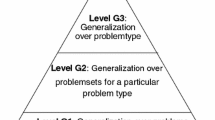Abstract
Automating high school timetabling is a challenging task. This problem is a well known hard computational problem which has been of interest to practitioners as well as researchers. High schools need to timetable their regular activities once per year, or even more frequently. The exact solvers might fail to find a solution for a given instance of the problem. A selection hyper-heuristic can be defined as an easy-to-implement, easy-to-maintain and effective ‘heuristic to choose heuristics’ to solve such computationally hard problems. This paper describes the approach of the team hyper-heuristic search strategies and timetabling (HySST) to high school timetabling which competed in all three rounds of the third international timetabling competition. HySST generated the best new solutions for three given instances in Round 1 and gained the second place in Rounds 2 and 3. It achieved this by using a fairly standard stochastic search method but significantly enhanced by a selection hyper-heuristic with an adaptive acceptance mechanism.




Similar content being viewed by others
References
Abramson, D. (1991). Constructing school timetables using simulated annealing: Sequential and parallel algorithms. Management Science, 37(1), 98–113.
Abramson, D., & Dang, H. (1993). School timetables: A case study in simulated annealing. In Applied simulated annealing, lecture notes in economics and mathematical systems (Vol. 396, pp. 103–124). Berlin: Springer.
Abramson, D., Dang, H., & Krisnamoorthy, M. (1999). Simulated annealing cooling schedules for the school timetabling problem. Asia-Pacific Journal of Operational Research, 16, 1–22.
Beligiannis, G. N., Moschopoulos, C. N., Kaperonis, G. P., & Likothanassis, S. D. (2008). Applying evolutionary computation to the school timetabling problem: The greek case. Computers & Operations Research, 35(4), 1265–1280.
Bello, G. S., Rangel, M. C., & Boeres, M. C. S. (2008). An approach for the class/teacher timetabling problem. In PATAT ’08 proceedings of the 7th international conference on the practice and theory of automated timetabling.
Birbas, T., Daskalaki, S., & Housos, E. (2009). School timetabling for quality student and teacher schedules. Journal of Scheduling, 12(2), 177–197.
Broder, S. (1964). Final examination scheduling. Communication of the ACM, 7(8), 494–498.
Burke, E. K., Landa-Silva, J. D., & Soubeiga, E. (2005). Meta-heuristics: Progress as real problem solvers, chap. In Multi-objective hyper-heuristic approaches for space allocation and timetabling (pp. 129–158). Berlin: Springer.
Burke, E. K., Curtois, T., Hyde, M. R., Kendall, G., Ochoa, G., Petrovic, S., Rodríguez, J. A. V., & Gendreau, M. (2010a). Iterated local search vs. hyper-heuristics: Towards general-purpose search algorithms. In IEEE congress on evolutionary computation (pp. 1–8).
Burke, E. K., Hyde, M., Kendall, G., Ochoa, G., Özcan, E., & Woodward, J. R. (2010b). A classification of hyper-heuristics approaches. In M. Gendreau, & J. Y. Potvin (Eds.), Handbook of metaheuristics, international series in operations research & management science (2nd edn., Vol. 57, pp. 449–468). Berlin: Springer, chap 15.
Burke, E. K., Gendreau, M., Hyde, M., Kendall, G., Ochoa, G., Özcan, E., et al. (2013). Hyper-heuristics: A survey of the state of the art. Journal of the Operational Research Society, 64(12), 1695–1724.
Chakhlevitch, K., & Cowling, P. (2005). Choosing the fittest subset of low level heuristics in a hyperheuristic framework. In Proceedings of 5th European conference on evolutionary computation in combinatorial optimization (EvoCOP2005), lecture notes in computer science (Vol. 3448, pp. 25–33). Berlin: Springer.
Chakhlevitch, K., & Cowling, P. (2008). Hyperheuristics: Recent developments. In C. Cotta, M. Sevaux, & K. Srensen (Eds.), Adaptive and multilevel metaheuristics, studies in computational intelligence (Vol. 136, pp. 3–29). Berlin: Springer.
Colorni, A., Dorigo, M., & Maniezzo, V. (1992). A genetic algorithm to solve the timetable problem. Technical report. Technical Report No. 90-060, Politecnico di Milano, Italy.
Corne, D., Ross, P., & Fang, H. L. (1994). Fast practical evolutionary timetabling. In Selected papers from AISB workshop on evolutionary computing (pp. 250–263). London: Springer.
Cowling, P., & Chakhlevitch, K. (2003). Hyperheuristics for managing a large collection of low level heuristics to schedule personnel. In Proceedings of the 2003 congress on evolutionary computation (pp. 1214–1221).
Cowling, P., Kendall, G., & Soubeiga, E. (2001). A hyperheuristic approach to scheduling a sales summit. In Selected papers from the third international conference on practice and theory of automated timetabling (pp. 176–190). London: Springer.
de Werra, D. (1997). The combinatorics of timetabling. European Journal of Operational Research, 96(3), 504–513.
Erben, W., & Keppler, J. (1996). A genetic algorithm solving a weekly course-timetabling problem. In E. Burke & P. Ross (Eds.), Practice and theory of automated timetabling, lecture notes in computer science (Vol. 1153, pp. 198–211). Berlin: Springer.
Even, S., Itai, A., & Shamir, A. (1976). On the complexity of timetable and multicommodity flow problems. SIAM Journal on Computing, 5(4), 691–703.
Filho, G. R., Antonio, L., & Lorena, L. A. N. (2001). A constructive evolutionary approach to school timetabling. In Applications of evolutionary computing lecture (pp. 130–139). Berlin: Springer.
Fisher, H., & Thompson, G. L. (1963). Probabilistic learning combinations of local job-shop scheduling rules. In J. F. Muth & G. L. Thompson (Eds.), Industrial scheduling (pp. 225–251). New Jersey: Prentice-Hall Inc.
Hertz, A. (1992). Finding a feasible course schedule using a tabu search. Discrete Applied Mathematics, 35, 255–270.
Jacobsen, F., Bortfeldt, A., & Gehring, H. (2006). Timetabling at German secondary schools: Tabu search versus constraint Programming. In: Proceedings 6th international conference on the practice and theory of automated timetabling, PATAT2006 (pp. 439–442).
Kannan, A., van den Berg, G., & Kuo, A. (2012). Schedule to personalize learning. Interfaces, 42(5), 437–448.
Kautz, H., Horvitz, E., Ruan, Y., Gomes, C., & Selman, B. (2002). Dynamic restart policies. In Eighteenth national conference on artificial intelligence (pp. 674–681). American Association for Artificial Intelligence: Menlo Park, CA.
Kendall, G., & Mohamad, M. (2004). Channel assignment optimisation using a hyper-heuristic. In Proceedings of the 2004 IEEE conference on cybernetic and intelligent systems (CIS2004), Singapore (pp. 790–795).
Kingston, J. (2005). A tiling algorithm for high school timetabling. In E. Burke & M. Trick (Eds.), Practice and theory of automated timetabling V, lecture notes in computer science (Vol. 3616, pp. 208–225). Berlin: Springer.
Lourenço, H. R., Martin, O. C., & Stützle, T. (2010). Iterated local search: Framework and applications. In M. Gendreau & J. Y. Potvin (Eds.), Handbook of metaheuristics, international series in operations research and management science (Vol. 146, pp. 363–397). Berlin: Springer.
Luby, M., Sinclair, A., & Zuckerman, D. (1993). Optimal speedup of Las Vegas algorithms. Information Processing Letters, 47(4), 173–180.
Marte, M. (2007). Towards constraint-based school timetabling. Annals of Operations Research, 155, 207–225.
McCollum, B., Schaerf, A., Paechter, B., McMullan, P., Lewis, R., Parkes, A. J., et al. (2010). Setting the research agenda in automated timetabling: The second international timetabling competition. INFORMS Journal on Computing, 22(1), 120–130.
Moura, A. V., & Scaraficci, R. A. (2010). A GRASP strategy for a more constrained school timetabling problem. International Journal of Operational Research, 7, 152–170.
Mustafa, M. (2012). Intelligent hyperheuristics: A tool for solving generic optimisation problems. PhD thesis. Belgium: Department of Computer Science, KU Leuven.
Özcan, E., & Kheiri, A. (2011). A hyper-heuristic based on random gradient, greedy and dominance. In E. Gelenbe, R. Lent, & G. Sakellari (Eds.), ISCIS (pp. 557–563). Berlin: Springer.
Özcan, E., Bilgin, B., & Korkmaz, E. E. (2008). A comprehensive analysis of hyper-heuristics. Intelligent Data Analysis, 12(1), 3–23.
Özcan, E., Bykov, Y., Birben, M., & Burke, E. (2009). Examination timetabling using late acceptance hyper-heuristics. In Evolutionary computation, 2009. CEC ’09. IEEE Congress on (pp. 997–1004).
Özcan, E., Parkes, A. J., & Alkan, A. (2012). The interleaved constructive memetic algorithm and its application to timetabling. Computers & Operations Research, 39(10), 2310–2322.
Pillay, N. (2010a). An overview of school timetabling research. In Proceedings of the 8th international conference on the practice and theory of automated timetabling (PATAT 2010) (pp. 321–335).
Pillay, N. (2010b). A study into the use of hyper-heuristics to solve the school timetabling problem. In Proceedings of the 2010 annual research conference of the South African institute of computer scientists and information technologists, ACM, New York, NY, USA, SAICSIT ’10 (pp. 258–264).
Pillay, N. (2012). Hyper-heuristics for educational timetabling. In Proceedings of the ninth international conference on the practice and theory of automated timetabling (PATAT 2012).
Pisinger, D., & Ropke, S. (2007). A general heuristic for vehicle routing problems. Computers and Operations Research, 34, 2403–2435.
Post, G., Ahmadi, S., Daskalaki, S., Kingston, J. H., Kyngas, J., Nurmi, C., et al. (2012). An XML format for benchmarks in high school timetabling. Annals of Operations Research, 194(1), 385–397.
Post, G., Gaspero, L. D., Kingston, J. H., McCollum, B., & Schaerf, A. (2012). The third international timetabling competition. In Proceedings of the ninth international conference on the practice and theory of automated timetabling (PATAT 2012).
Raghavjee, R., & Pillay, N. (2008). An application of genetic algorithms to the school timetabling problem. In Proceedings of the 2008 annual research conference of the South African Institute of computer scientists and information technologists on IT research in developing countries: Riding the wave of technology, ACM, New York, NY, USA, SAICSIT ’08 (pp. 193–199).
Raghavjee, R., & Pillay, N. (2010). Using genetic algorithms to solve the South African school timetabling problem. In Second world congress on nature & biologically inspired computing, NaBIC 2010, 15–17 December 2010 (pp. 286–292). Kitakyushu: IEEE.
Ross, P. (2005). Hyper-heuristics. In E. K. Burke, & G. Kendall (Eds.) Search methodologies: Introductory tutorials in optimization and decision support techniques (pp. 529–556). Berlin: Springer, chap 17.
Ross, P., Corne, D., & Fang, H. L. (1994). Improving evolutionary timetabling with delta evaluation and directed mutation. In Y. Davidor, H. P. Schwefel, & R. Männer (Eds.), Parallel problem solving from nature, PPSN III, lecture notes in computer science (Vol. 866, pp. 556–565). Berlin: Springer.
Schaerf, A. (1996). Tabu search techniques for large high-school timetabling problems. In Proceedings of the thirteenth national conference on Artificial intelligence—volume 1, AAAI Press, AAAI’96 (pp 363–368).
Smith, K. A., Abramson, D., & Duke, D. (2003). Hopfield neural networks for timetabling: formulations, methods, and comparative results. Computers & Industrial Engineering, 44(2), 283–305.
Valouxis, C., & Housos, E. (2003). Constraint programming approach for school timetabling. Computers and Operations Research, 30(10), 1555–1572.
Wilke, P., Gröbner, M., & Oster, N. (2002). A hybrid genetic algorithm for school timetabling. In Proceedings of the 15th Australian joint conference on artificial intelligence: Advances in artificial intelligence. Springer: London, AI ’02 (pp. 455–464).
Acknowledgments
This work is supported in part by the UK EPSRC under Grant EP/F033214/1—the LANCS Initiative in Foundational Operational Research: Building Theory for Practice.
Author information
Authors and Affiliations
Corresponding author
Rights and permissions
About this article
Cite this article
Kheiri, A., Özcan, E. & Parkes, A.J. A stochastic local search algorithm with adaptive acceptance for high-school timetabling. Ann Oper Res 239, 135–151 (2016). https://doi.org/10.1007/s10479-014-1660-0
Published:
Issue Date:
DOI: https://doi.org/10.1007/s10479-014-1660-0




